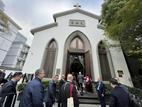"It has long been customary for believers to attend services seated before the pulpit, listening as the pastor preaches from the stage. Today, however, I invite you to join me in connecting with the Lord through meditation."
On April 17, Holy Wednesday, a church in central China held a special worship service centered on meditation and the Holy Communion. The service was led by a young preacher, a graduate of Nanjing Union Theological Seminary, who sought to reintroduce the meditative tradition of the Catholic Church into the congregation's devotional life. Departing from the conventional order of service—comprising praise and worship, an opening prayer, Scripture reading, a sermon, and a closing prayer—he offered a more contemplative format.
At the start of the service, once the congregation was seated, the preacher asked, "You're probably familiar with the suffering and resurrection. But let me ask—how many Easters have you experienced?" An elderly member responded proudly, "The 40th." This open and unscripted exchange between the preacher and congregation set the tone for the reflective and intimate nature of the following meditation.
The worship service consisted of four parts, beginning with a reflection on the significance of salvation through the blood of the Passover lamb, as recorded in Exodus 12. Following a five-to-ten-minute background explanation, the young preacher guided the congregation in a careful reading of the passage and led them in bowed-head prayer. The second section focused on responding to God's grace through Psalm 116, which was then followed by a profound exposition of the meaning of the Holy Communion in 1 Corinthians 11. The final portion centered on Jesus' humility as demonstrated in the foot-washing of his disciples in John 13, encouraging the attendees to grasp the true essence of "loving and serving one another." To help the congregation engage more deeply with the Scripture, the preacher incorporated various reading techniques, including unison reading, call-and-response, and role-playing.
This structure was a novel experience for the churchgoers, who often "rushed to read" the next passage. During the meditative moments, most attendees engaged in whispered prayers. One elderly brother rested his hands on his open Bible, fingers interlaced in prayer, while another man in the back row leaned forward, his forehead resting on his hand, lost in contemplation. A woman declared, "Oh Lord, forgive them, for they do not know what they are doing."
During the Holy Communion that followed, one of the most moving moments unfolded. An elderly woman, her hair streaked with grey and white, reverently lifted the cup and bread in both hands before her face. Her frail body leaned slightly forward as tears filled her eyes and she wept silently.
Following the service, the preacher acknowledged that "the response from the congregation was not as I had expected." It was, after all, the first time the service had been conducted in this format within the chapel. He noted the difficulty in managing both the number of attendees and the overall atmosphere, even though similar worship formats had been held in church groups and fellowships.
He expressed hope that the congregation would grasp the core message of his sermon—that beyond simply listening to the message, Christians should engage in reflection and response during the communion and Holy Wednesday. He emphasized, "Do not partake of the cup and the bread while uttering empty words."
Originally published by the Gospel Times
- Translated by Poppy Chan












